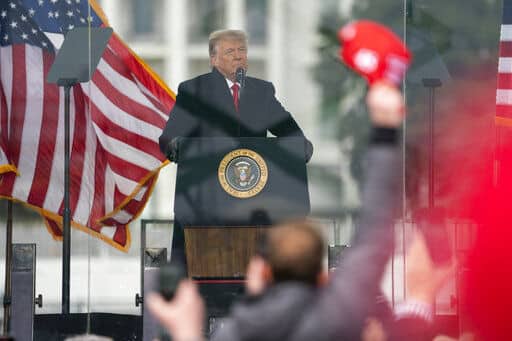
COLUMBUS, Ind. — Former President Donald Trump collected $48,410 in contributions from Columbus-area residents in the weeks immediately after the Nov. 3 presidential election as he supported unfounded claims of widespread voter fraud and sought to overturn the results of an election he lost.
Residents of Columbus, Seymour, North Vernon and Nashville made at least a combined 888 donations totaling $48,410.90 to Trump’s fundraising coffers from Nov. 3 to 23 via WinRed, a platform that the GOP uses to process online donations, according to records made public by the Federal Election Commission.
Columbus residents made up the bulk of the contributions, with 472 donations totaling $31,808. Seymour residents made 220 donations for a total of $7,149.90, followed by North Vernon residents, who made 107 donations totaling $5,642, and Nashville residents, who made 89 contributions for a total of $3,811.
The contributions were specifically earmarked for one of Trump’s committees, including Donald J. Trump for President Inc., Trump Make America Great Again Committee and Trump Victory.
By contrast, 2012 Republican presidential nominee Mitt Romney received two donations totaling $450 from Columbus-area residents after his defeat in the 2012 presidential election.
After losing the 2008 presidential election, Republican nominee John McCain’s received a combined three donations from the Columbus area for a total of $1,350.
While Columbus area residents have long made contributions to Trump’s campaign committees via WinRed — including $264,181 since late June 2019 — the rate of giving accelerated after the Nov. 3 presidential election, federal campaign finance records show.
In the month prior to Election Day, Columbus-area residents were donating, on average, $1,529 to Trump every day. After Election Day, that number jumped to about $2,420 per day, including a total of $29,553 the week immediately following the election.
The average contribution further increased to just over $2,714 per day in the 10 days after Nov. 7, when most media outlets, including Fox News, called the race in favor of Democrat Joe Biden.
Bartholomew County Republican Party Chair Barb Hackman said she was “a little bit” surprised to see so many contributions after an election, but said she thought the former president’s popularity in Bartholomew County, local support for his legal challenges to the election results and technology that made it easier for people to make contributions likely played a role in increase in donations.
In addition, having Columbus native and former Vice President Mike Pence on the ticket may have also contributed to the enthusiasm among voters, Hackman said. The Trump-Pence ticket carried Bartholomew County in the 2020 election with 61.7% of the vote, according to local records.
“During that time (after Election Day), the president was still saying that he hadn’t lost,” Hackman said. “You kind of have to remember what happened after the election. A lot of people still felt that there were still a lot of issues in these states with the election, and I think they were still hopeful that they would find more evidence or something (to help reverse the results).”
There is no evidence of widespread fraud in the 2020 election. In fact, election officials from both political parties have stated publicly that the election went well, and international observers confirmed there were no serious irregularities, The Associated Press reported.
But as Trump’s chances of re-election dwindled in the hours and days after the election, his campaign began bombarding supporters with hundreds of emails and text messages that made inaccurate claims about voter fraud and election irregularities, while requesting money to fight the outcome, according to wire reports.
And 365 people from the Columbus area sent him money, ranging from Cummins factory workers and health care workers at Columbus Regional Health and Schneck Medical Center to college professors. Two individuals made 15 separate contributions over a 19-day period after the election.
The Republic attempted to talk to several of the contributors on the federal list, which is a public record, but they did not respond.
Overall, contributions ranged from $0.25 to $2,800, including 273 contributions that were $10 or less and 189 that were $5 or less, federal campaign finance records show.
The median contribution was $25 and only 27 of the 888 contributions exceeded $100.
However, the Columbus area was not the only part of the country that saw a large number of contributions to Trump after Election Day.
A similar pattern was seen nationwide, reflecting, in part, changes in technology that have made it easier for people to donate directly to candidates and a trend where politicians – both Democrats and Republicans – are increasingly soliciting contributions from small donors, said Sarah Bryner, director of research and strategy at the Center for Responsive Politics, a nonpartisan Washington-based group that tracks the money going through the U.S. political system.
In Trump’s case, however, many of the donors likely “wanted to support his legal challenges,” Bryner told The Republic.
Filings with the Federal Election Commission show that Trump and the Republican Party raised $255.4 million during the eight weeks after his defeat in the 2020 election, The New York Times reported.
Trump’s post-election fundraising success is “definitely unusual,” Bryner said.
“(Trump) has had some of his best fundraising days of the cycle in the post-election period,” Bryner said. “It’s very unusual for somebody to do fundraising successfully after the election, whether they win or lose.”
Hackman said the Trump campaign ran promotions on contributions through social media and text messaging, including offering T-shirts, mugs and Make America Great Again hats in exchange depending on how much someone contributed.
In October, the Trump campaign starting allowing supporters to check a box on the former president’s website to opt into automatic recurring donations each week through mid-December, according to The New York Times.
The technology, social media ecosystem and way the Trump campaign sought out contributions was “totally different from when Mitt Romney was nominated,” Hackman said.
“A lot of it was mail,” Hackman said, referring to fundraising during the 2012 presidential election. “They asked for your donations by mail. You’d have to write out a check and send it in. …(The Trump campaign) made it very easy for you to be able to (donate). The technology changed.”
Though campaign donations have typically been a space for the wealthy, Bryner said the Center for Responsive Politics has been increasingly seeing contributions coming from small donors on both sides of the aisle that did not used to contribute in the past.
“The candidates are speaking to that,” Bryner said. “They’re soliciting it in a way that they didn’t even 10 years ago.”
— The Associated Press contributed to this report.




